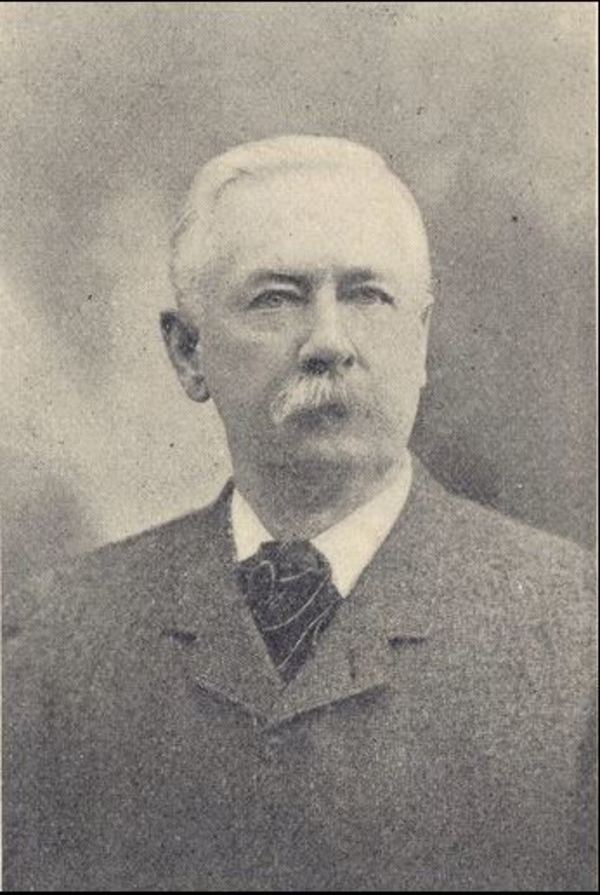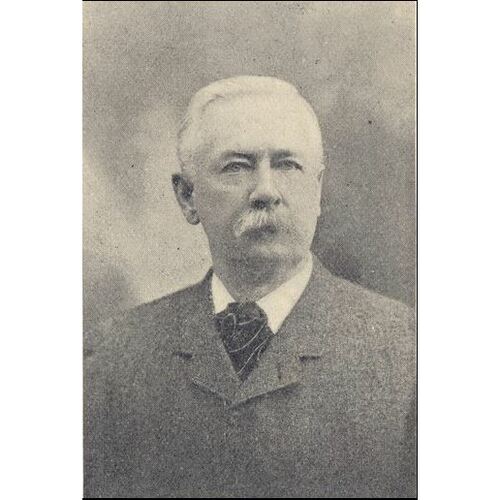
Source: Link
BARBER, JOHN ROAF, businessman, militia officer, and politician; b. 5 July 1841 in Georgetown, Upper Canada, second son of James Barber and Hannah Patrick; m. first 1 Jan. 1868 Mary Barclay, and they had three sons and three daughters; m. secondly 26 June 1900 Agnes Alberta Bessey in Georgetown, and they had a son; d. there 3 March 1917.
John Roaf Barber’s father originated in County Antrim (Northern Ireland), his mother in Berwick-upon-Tweed, England. Named after the Congregational minister John Roaf*, who visited Georgetown in 1841, Barber was educated at Georgetown public school, Streetsville grammar school, and Georgetown Academy. He planned to attend the Royal Military College in England, but stayed home instead to lend a hand in the family-run paper-milling business. Eventually he would earn acclaim as the dean of the Canadian paper trade.
About 1854 Barber’s father and uncles, who had been involved in woollen milling in Georgetown since 1837, established a rag-paper mill there. J. R. Barber became plant manager in 1861 under the eye of his father, who became sole proprietor in 1869. Upon his father’s death in 1880, he took over the Barber Paper Mills.
An enterprising and utilitarian businessman, Barber had recognized the need for paper products – the only major manufacturer of stationery in Canada in the 1870s appears to have been Alexander Buntin*. In 1876 Barber’s brother James and John Fitzallen Ellis of Brantford created Barber and Ellis Company, which would become one of the dominion’s largest manufacturers and wholesalers of stationery. Based in Toronto, it was incorporated in 1883, with J. R. Barber purchasing controlling interest and becoming president. In 1881 he had helped organize and had become first president of the Toronto Paper Manufacturing Company Limited; John Riordon* was vice-president and the shareholders included William Walter Copp*. Barber moved quickly to establish its operations: a site was acquired at Cornwall, Ont., and in 1883 the mill built there started producing newsprint and high-quality paper for writing, books, and lithographic work.
Initially the mill used wood pulp from Quebec, but it was not good enough. In 1886 Barber and another company official, Charles Riordon*, visited Europe to examine new methods being developed there for producing paper. Basing itself on Barber’s report, the company introduced at Cornwall a sulphite process for pulping wood; in 1887 it erected its own sulphite mill. Soon the company was supplying its own plant, and those of other paper firms, with what was acknowledged to be the finest pulp in Canada. By 1898 Barber was joining other major Canadian pulp producers, among them Ezra Butler Eddy*, to protest American restrictions on exports of pulp to the United States.
Barber’s other major initiative in the paper industry centred on power for manufacturing. By 1881 more power was required to operate the expanding Barber Paper Mills at Georgetown. Conscious of rapid developments in electrical technology, he chose to use a dynamo to harness the energy of the Credit River. He hired the Brush Electric Company of Cleveland, Ohio, to fabricate a 100-horse-power electric generator and a 60-horse-power, direct-current motor, the largest built by the company to that point. Housed in a stone building downstream from the mills, the dynamo went into operation in 1888; the energy produced was used in combination with a 75-horse-power, water-driven turbine at the mills. The dynamo was the first plant in Canada to generate hydroelectric power for use in industrial production. In 1909 discussions began regarding the sale of power to Georgetown by the Hydro-Electric Power Commission of Ontario [see Sir Adam Beck*]. Barber headed the local committee in these talks, and on 31 July 1913 publicly generated electricity came to the Barber Paper Mills.
John Roaf Barber’s position within the industry was enhanced by his founding directorship in 1883 in the Dominion Paper Making and Staining Company Limited, his executive positions in both the Spanish River Pulp and Paper Company Limited of Toronto (incorporated 1899) and the Nepigon Pulp, Paper and Manufacturing Company Limited of Port Arthur (incorporated 1900), and his take-over in 1903–4 of the Canada Coated Paper Mill at Georgetown.
In addition to his paper operations, he was a director of the Dominion Consolidated Mines Company Limited and the Anglo-American Fire Insurance Company and president of a host of other concerns, among them Floral View Greenhouse Company Limited in Georgetown, Leadville Mining Company in Colorado, Canadian Brass and Tube Works in Toronto, and, from 1897, Inter-Ocean Mining and Prospecting Company of Toronto Limited.
Barber was an integral member of his community. Between 1861 and 1905 he served in the militia, first in the Georgetown Volunteer Militia Infantry Company and then in the 20th (Halton) Battalion (the Lorne Rifles). He saw active service in 1866, at Ridgeway against the Fenians [see Alfred Booker*]. He achieved the rank of major in 1876 and for many years was paymaster of the 20th Battalion. A president of the Mechanics’ Institute in Georgetown, he also rose to become master of Credit Masonic Lodge No.219 in 1874. He chaired the first meeting of the board of high-school trustees in 1886, pledging that within three years a separate high-school building would be erected. Two years later property was purchased for that purpose. A Congregationalist until at least 1898, he was on the roll of Knox Presbyterian Church from 1908 to his death and likely served on its board of managers. His community involvement led him as well into the political arena: he sat on the local council and was reeve of Georgetown from January 1867 to December 1876 and again in 1882, when he also served as warden of Halton County. From 1898 to 1904 he was the Liberal mpp for Halton.
For the last three decades of his life, Barber and his family resided in one of the area’s more imposing mansions. Built around 1883 and named after his mother’s birthplace, Berwick Hall was designed, at least in part, by prominent Toronto architect Edward James Lennox* in the Queen-Anne Revival style. A garage, the first one to be built in Georgetown for an automobile, was erected in 1911. Barber suffered a heart attack that year and retired from business in 1912. He passed away in his 76th year and was buried at Greenwood Cemetery in Georgetown. The Acton Free Press described his funeral as “one of the largest” ever seen there.
[Details for the biography of John Roaf Barber were drawn from the reminiscences of Colonel J. R. Barber and John Lee Watson, both of Georgetown, Ont., interviewed by the author in 1991. r.t.r.]
AO, RG 80-27-2, 17: 121. Halton Board of Education (Burlington, Ont.), Minutes of the first meeting of the board of high-school trustees, Georgetown, 1886. Halton Hills Civic Centre (Georgetown), Village of Georgetown, minute-book and by-laws. Halton Hills Public Libraries (Georgetown), Georgetown Congregational Church records. Halton Land Registry Office (Milton, Ont.), Probate records, no.2203. Halton Region Museum/Arch. (Milton), J. R. Barber, declaration of office, 1882. Knox Presbyterian Church (Georgetown), Minutes of annual general meetings; Reg. of baptisms. Ontario Heritage Foundation (Toronto), “The Barber heritage: 140 years in Georgetown, June 2–26, 1977 . . .” (brochure advertising unveiling of plaque commemorating J. R. Barber, 1977). Acton Free Press (Acton, Ont.), 2 Aug. 1883, 8 March 1917. Georgetown Herald, 2 Feb. 1898. Globe and Mail, 22 Oct. 1948. Toronto Daily Star, 25 Oct. 1948. Canadian album (Cochrane and Hopkins), vol.2. Canadian men and women of the time (Morgan; 1898 and 1912). George Carruthers, Paper-making (Toronto, 1947). CPG, 1903. Directory, Peel and Halton counties, 1866/67. Reinhard Filter, The Barber dynamo: a perspective (Cheltenham, Ont., 1977). J. R. McDonald, Halton sketches (Acton, 1976). Newspaper reference book.
Cite This Article
Robert T. Royal, “BARBER, JOHN ROAF,” in Dictionary of Canadian Biography, vol. 14, University of Toronto/Université Laval, 2003–, accessed April 25, 2025, https://www.biographi.ca/en/bio/barber_john_roaf_14E.html.
The citation above shows the format for footnotes and endnotes according to the Chicago manual of style (16th edition). Information to be used in other citation formats:
| Permalink: | https://www.biographi.ca/en/bio/barber_john_roaf_14E.html |
| Author of Article: | Robert T. Royal |
| Title of Article: | BARBER, JOHN ROAF |
| Publication Name: | Dictionary of Canadian Biography, vol. 14 |
| Publisher: | University of Toronto/Université Laval |
| Year of revision: | 1998 |
| Access Date: | April 25, 2025 |



